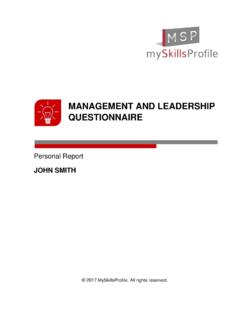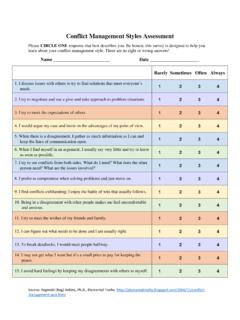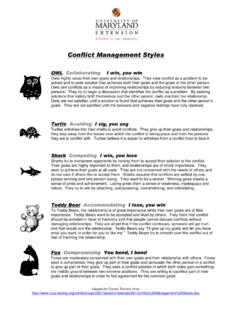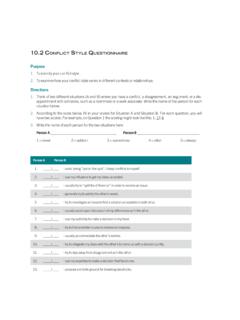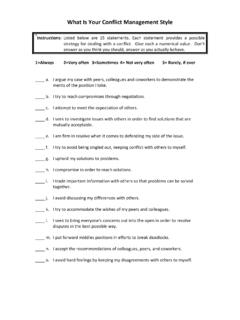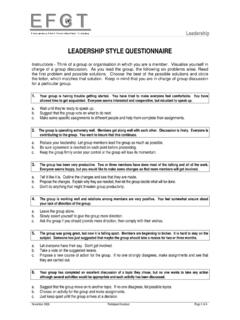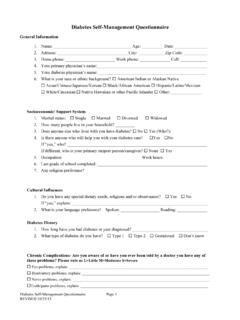Transcription of Internal Control Questionnaire and Assessment
1 DRAFT October 14, 2016 (Pending HUD Legal Counsel Approval) Internal Control Questionnaire and Assessment 2 CFR (a) of the Uniform Administrative Requirements, Cost Principles, and Audit Requirement for Federal Awards, states that the non-Federal entity must establish and maintain effective Internal Control over the Federal award that provides reasonable assurance that the non-Federal entity is managing the Federal award in compliance with Federal statutes, regulations, and the terms and conditions of the Federal award. These Internal controls should be in compliance with guidance in Standards for Internal Control in the Federal Government issued by the Comptroller General of the United States and the Internal Control Integrated Framework, issued by the Committee of Sponsoring Organizations of the Treadway Commission (COSO).
2 Internal Control Primer Basics of Internal Control In 1992, the Committee of Sponsoring Organizations (COSO)1 of the National Commission on Fraudulent Financial Reporting (also known as the Treadway Commission) published a document called: Internal Control Integrated Framework, which defined Internal Control as a process, effected by an entity s board of directors, management and other personnel, designed to provide reasonable assurance regarding the achievement of objectives in three categories: 1. Effectiveness and efficiency of operations 2. Reliability of financial reporting, and 3. Compliance with applicable laws and regulations Internal Control can be judged as effective in each of these categories if the board of directors and management have reasonable assurance that: 1. They understand the extent to which the entity s operations objectives are being achieved.
3 2. Published financial statements are being prepared reliably. 3. Applicable laws and regulations are being complied with. The COSO Framework went on to say that Internal Control consists of five interrelated components as follows: 1 The Committee of Sponsoring Organizations consists of the American Institute of CPAs (AICPA), the Institute of management Accountants (IMA), the Institute of Internal Auditors (IIA), Financial Executives International (FEI), and the American Accounting Association (AAA). DRAFT October 14, 2016 (Pending HUD Legal Counsel Approval) A Job Aid - Internal Control Questionnaire and Assessment 1. Control environment. Sometimes referred to as the tone at the top of the organization, meaning the integrity, ethical values and competence of the entity s people, management s philosophy and operating style, the way management assigns authority and responsibility, organizes and develops its people, and the attention and direction provided by the board of directors.
4 It is the foundation for all other components of Internal Control , providing discipline and structure. 2. Risk Assessment . The identification and analysis of relevant risks to achieve the objectives which form the basis to determine how risks should be managed. This component should address the risks, both Internal and external, that must be assessed. Before conducting a risk Assessment , objectives must be set and linked at different levels. 3. Control activities. Policies and procedures that help ensure that management directives are carried out. Control activities occur throughout the organization at all levels in all functions. These include activities like approvals, authorizations, verifications, reconciliations, reviews of operating performance, security of assets and segregation of duties. 4. Information and communication.
5 Addresses the need in the organization to identify, capture and communicate information to the right people to enable them to carry out their responsibilities. Information systems within the organization are key to this element of Internal Control . Internal information, as well as external events, activities and conditions must be communicated to enable management to make informed business decisions and for external reporting purposes. 5. Monitoring. The Internal Control system must be monitored by management and others in the organization. This is the framework element that is associated with the Internal audit function in the company, as well as other means of monitoring such as general management activities and supervisory activities. It is important that Internal Control deficiencies be reported upstream, and that serious deficiencies are reported to top management and the board of directors.
6 Subsequent sections of this document emphasize the 17 Principles of Internal Control developed by the Committee of Sponsoring Organizations of the Treadway Commission (COSO) and presented in the Internal Control Integrated Framework (2013). The five components of Internal Control listed above are basically identical to the five standards of Internal Control and reflect the same concepts that the Standards for Internal Control in the Federal Government utilizes. The principles are reflected in groupings of questions related to major areas of Control focus within the organization. Each question represents an element or characteristic of Control that is or can be used to promote the assurance that operations are executed as management intended. DRAFT October 14, 2016 (Pending HUD Legal Counsel Approval) A Job Aid - Internal Control Questionnaire and Assessment It should be noted that Tribes/TDHEs (as non-federal entities) may have adequate Internal controls even though some or all of the listed characteristics are not present.
7 Tribes/TDHEs could have other appropriate Internal controls operating effectively that are not included here. The Tribe/TDHE will need to exercise judgment in determining the most appropriate and cost effective Internal Control in a given environment or circumstance to provide reasonable assurance for compliance with Federal program requirements. Completing the Document On a scale of 1 to 5, with 1 indicating the greatest need for improvements in Internal controls and 5 indicating that a strong system of Internal controls already exists, select the number that best describes your current operating environment. Please provide details in the comments/explanations field for each statement with a score of 1 or 2. DRAFT October 14, 2016 (Pending HUD Legal Counsel Approval) A Job Aid - Internal Control Questionnaire and Assessment Control ENVIRONMENT Self- Assessment of Policies, Procedures, and Processes Weak Strong 1 2 3 4 5 Comments/Explanations Principle 1.
8 The organization demonstrates a commitment to integrity and ethical values. 1. TRIBE/TDHE management and the board s expectations translate into an organizational statement of beliefs, values, and standards of conduct that the staff exhibit daily. 2. TRIBE/TDHE s standards of conduct are communicated and reinforced to all levels of the TRIBE/TDHE. 3. Processes are in place to evaluate the performance of staff against expected standards of conduct. Principle 2. The board demonstrates independence from management and exercises oversight of the development and performance of Internal Control . 4. The Board /Council define, maintain, and periodically evaluate the skills and expertise needed among its members to enable them to question and scrutinize management s activities and present alternate views. 5.
9 How well does the committee that oversees Internal Control over financial reporting and the integrity and transparency of those reports complete these tasks? 6. The board establishes the expectations and evaluates the performance of the chief executive officer or equivalent role. Principle 3. management establishes, with board oversight, structures, reporting lines, and appropriate authorities and responsibilities in the pursuit of objectives. 7. The organizational structure is appropriate for the size and complexity of the TRIBE/TDHE. DRAFT October 14, 2016 (Pending HUD Legal Counsel Approval) A Job Aid - Internal Control Questionnaire and Assessment 8. Specific lines of authority and responsibility are established to ensure compliance with federal and state laws and regulations.
10 9. The TRIBE/TDHE management /board understands the importance of Internal controls, including the division of responsibility. Principle 4. The organization demonstrates a commitment to attract, develop, and retain competent individuals in alignment with objectives. 10. Regular employee evaluations are documented and shared with employees. 11. The TRIBE/TDHE continuously provides mentoring and training opportunities needed to attract, develop, and retain sufficient and competent personnel. 12. The TRIBE/TDHE checks credentials, references, and past work experience of potential new hires. Principle 5. The organization holds individuals accountable for their Internal Control responsibilities in the pursuit of objectives. 13. The TRIBE/TDHE holds periodic training to ensure employees are aware of their duties pertaining to Internal Control ( segregation of duties, safeguarding TRIBE/TDHE assets).










